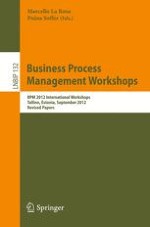This book constitutes the refereed proceedings of 12 international workshops held in Tallinn, Estonia, in conjunction with the 10th International Conference on Business Process Management, BPM 2012, in September 2012.
The 12 workshops comprised Adaptive Case Management and Other Non-Workflow Approaches to BPM (ACM 2012), Business Process Design (BPD 2012), Business Process Intelligence (BPI 2012), Business Process Management and Social Software (BPMS2 2012), Data- and Artifact-Centric BPM (DAB 2012), Event-Driven Business Process Management (edBPM 2012), Empirical Research in Business Process Management (ER-BPM 2012), Process Model Collections (PMC 2012), Process-Aware Logistics Systems (PALS 2012), Reuse in Business Process Management (rBPM 2012), Security in Business Processes (SBP 2012), and Theory and Applications of Process Visualization (TAProViz 2012). The 56 revised full papers presented were carefully reviewed and selected from 141 submissions.
